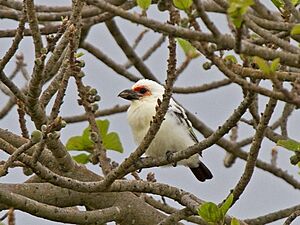Chaplin's barbet facts for kids
Quick facts for kids Chaplin's barbet |
|
|---|---|
 |
|
| Conservation status | |
| Scientific classification | |
| Genus: |
Lybius
|
| Species: |
chaplini
|
The Chaplin's Barbet (also called the Zambian Barbet) is a special kind of bird. Its scientific name is Lybius chaplini. This bird is super unique because it's the only bird species found nowhere else in the world except Zambia. That means it's endemic to south-central Zambia.
It lives in areas between the Upper Kafue River and Kabanga in the Kalomo District. You can find it in moist savanna areas and on arable land (farmland). Sadly, its home is shrinking because of habitat loss. Because of this, the Chaplin's Barbet is now considered a Vulnerable species. This means it needs our help to survive!
What Does Chaplin's Barbet Look Like?
The Chaplin's Barbet is a small, plump bird. It measures about 19 cm (7.5 in) long. It usually weighs between 64–75 g (2.3–2.6 oz). This barbet has a big head and a strong beak with bristles. Its feathers are mostly white. It has bright red feathers around its eyes. Its tail is black, and its wings are black with yellow edges. These birds love to live in open woodlands. They especially like places where fig trees grow. Fig trees are important for them to find food and build their nests.
How Do They Communicate?
Chaplin's Barbets often live in small groups. These groups usually have two to six birds. They are very protective of their home areas. When they talk to each other, they make loud snapping sounds with their beaks. They also make a chorus of buzzy, grating noises. It sounds a bit like a noisy cackle that gets faster and faster!
Where Do They Build Their Nests?
The breeding season for Chaplin's Barbets is from August to November. They build their nests inside holes in the branches of fig trees. Female barbets lay between two and four eggs. The parents take turns sitting on the eggs. This incubation period lasts for about 13 to 15 days. Both parents also share the job of raising their young chicks.
Sometimes, a bird called a lesser honeyguide might lay its eggs in a barbet's nest. The honeyguide leaves its eggs for the barbets to raise. The barbets then take care of the honeyguide chicks as if they were their own.


